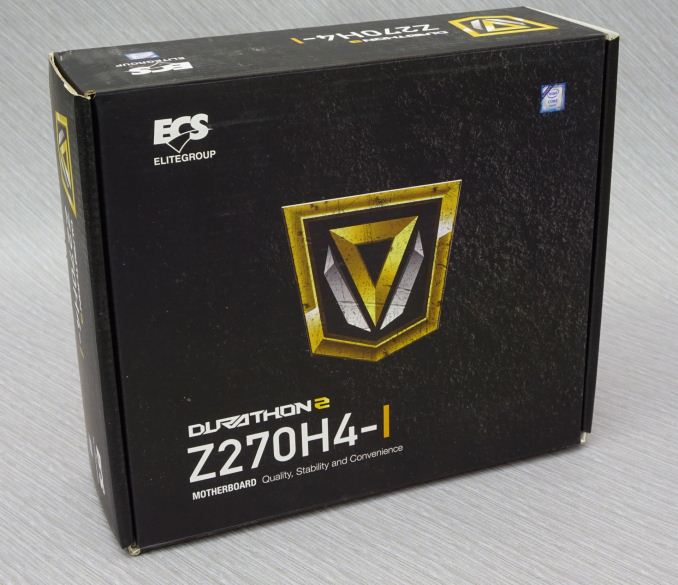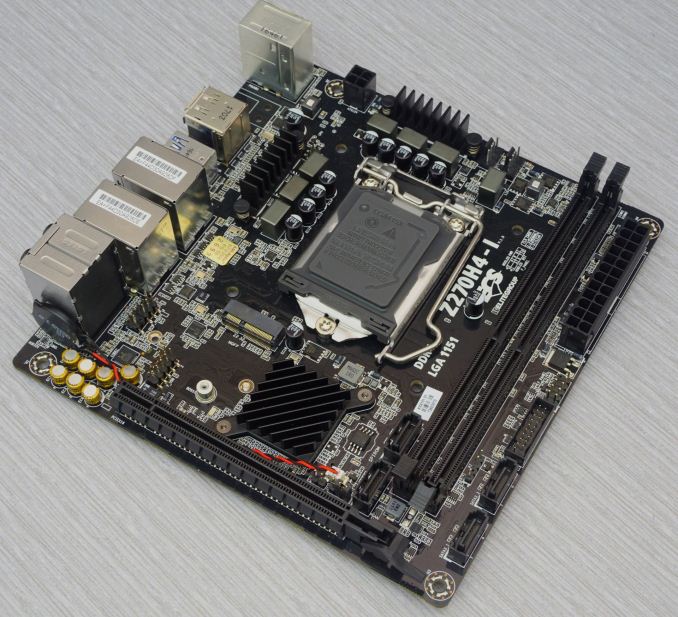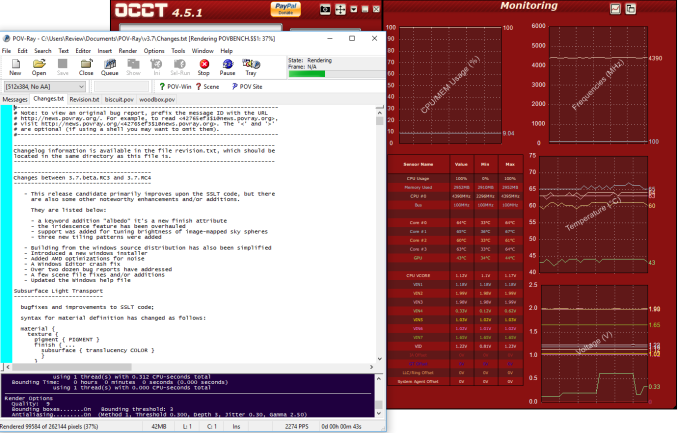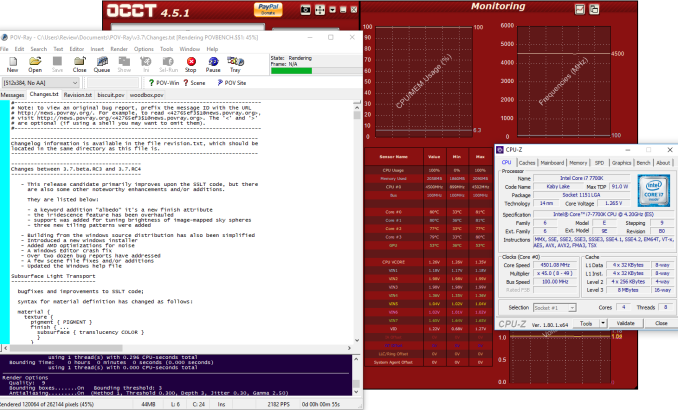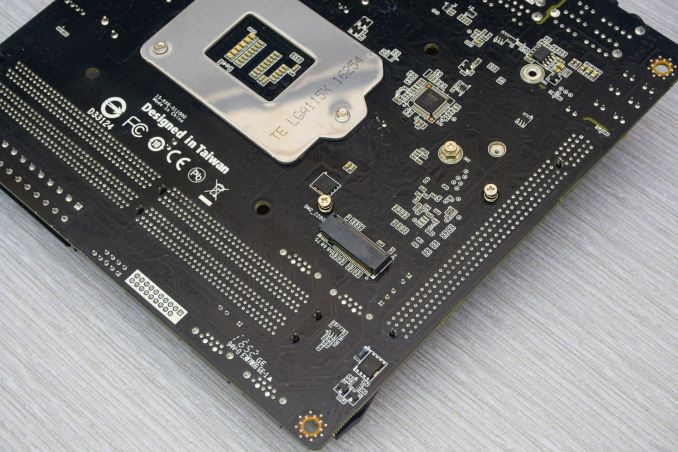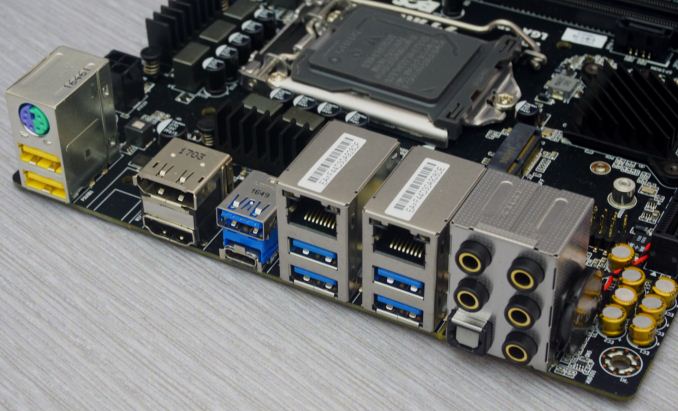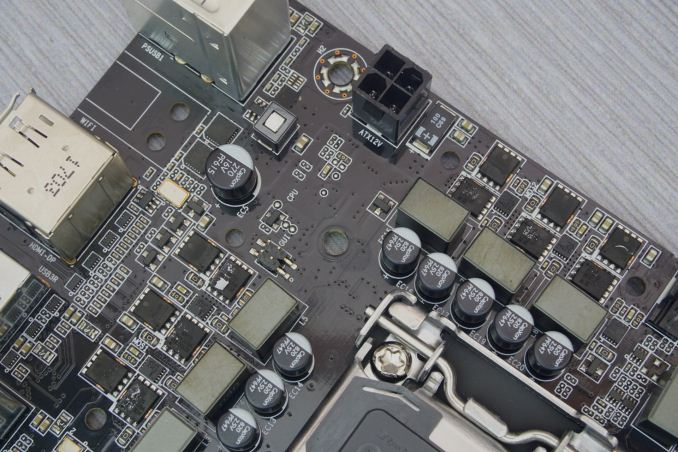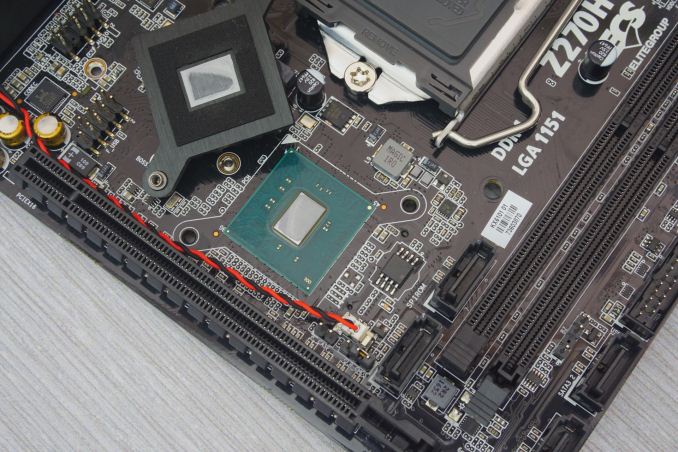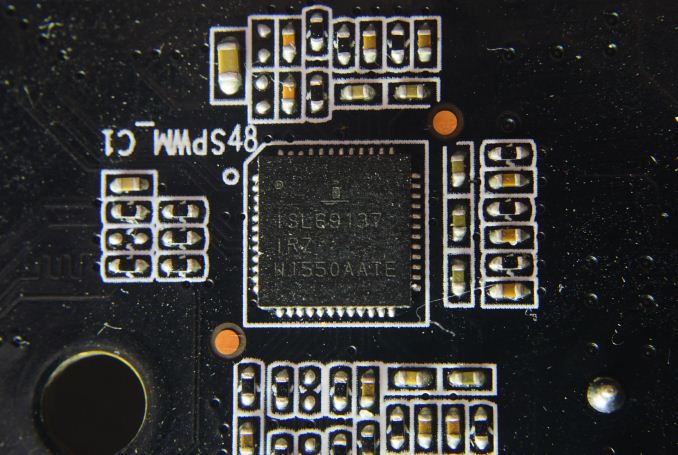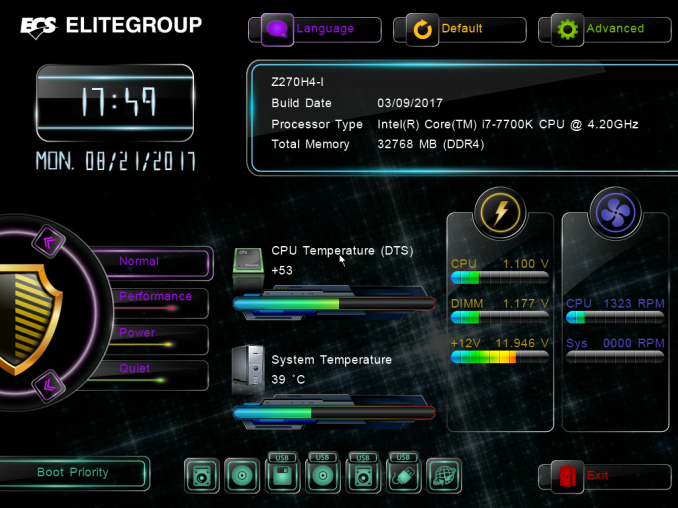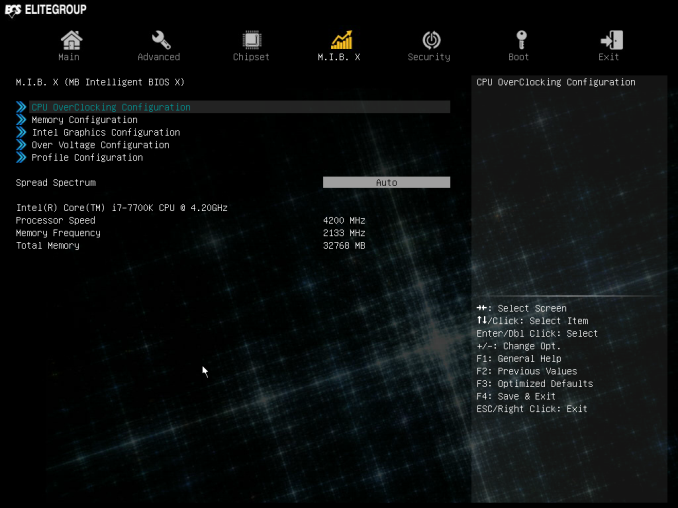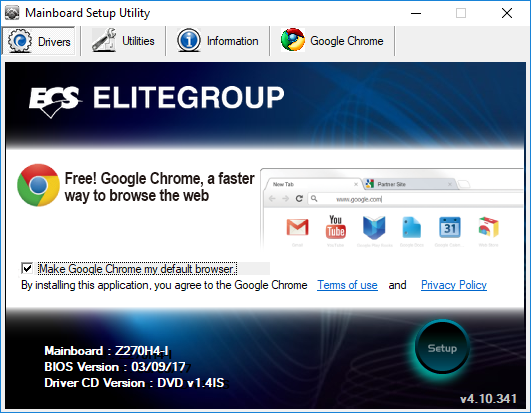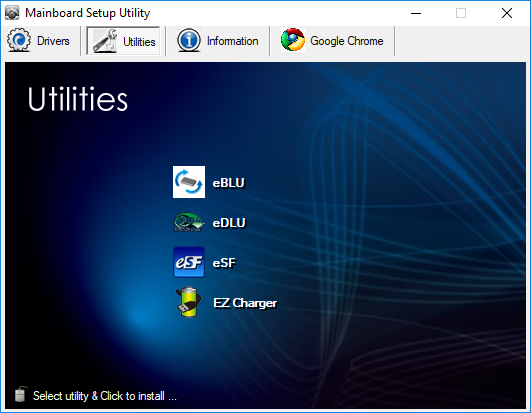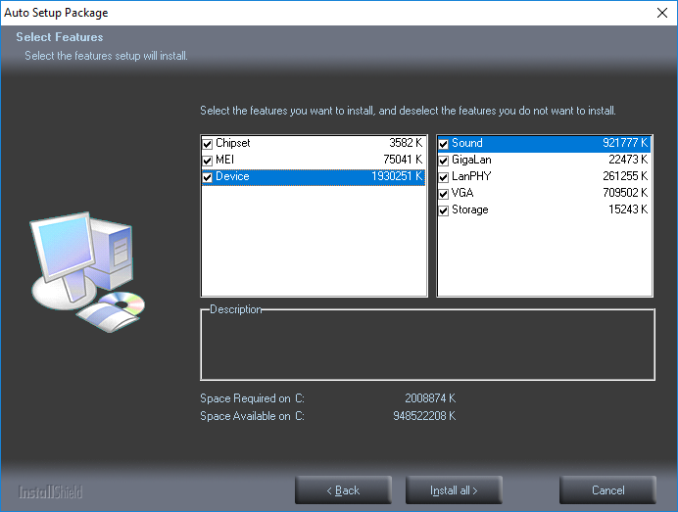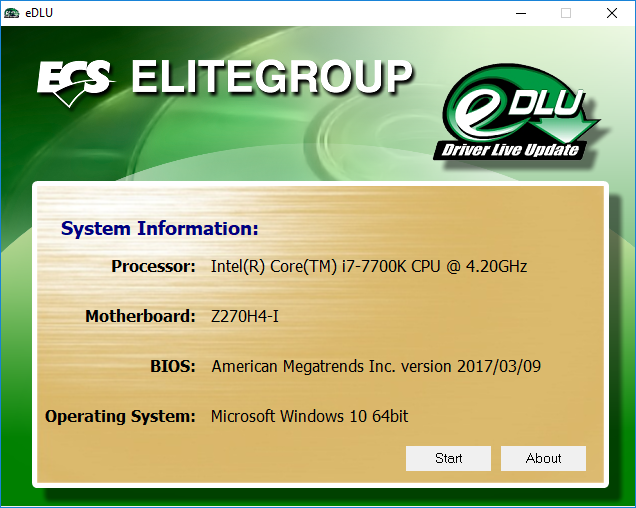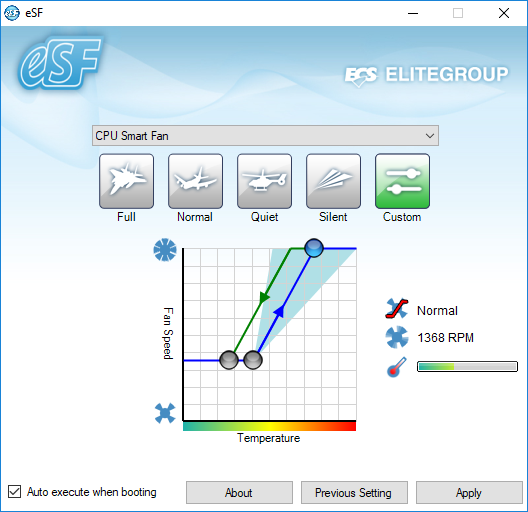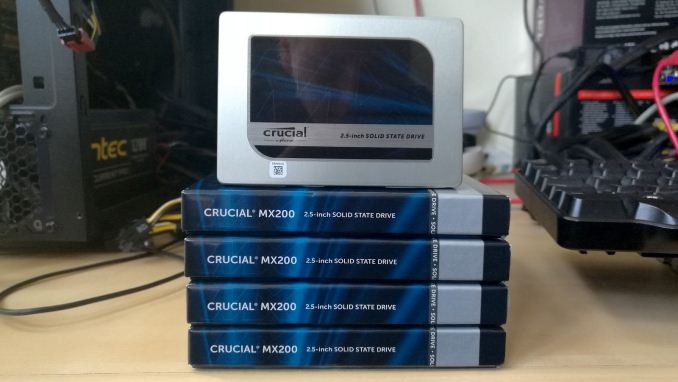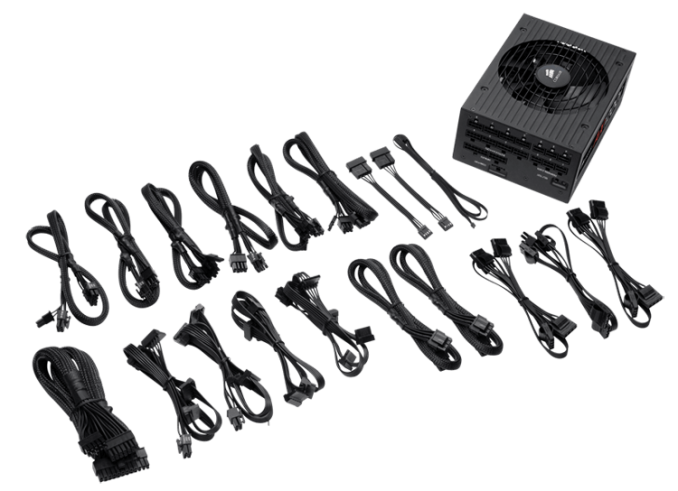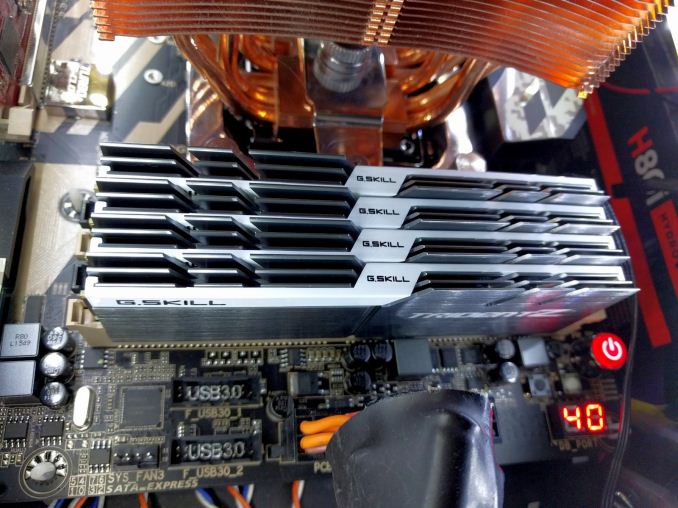
Original Link: https://www.anandtech.com/show/11774/the-ecs-z270h4i-durathon-2-mini-itx-motherboard-review
The ECS Z270H4-I Durathon 2 Mini ITX Motherboard Review
by E. Fylladitakis on September 5, 2017 10:30 AM EST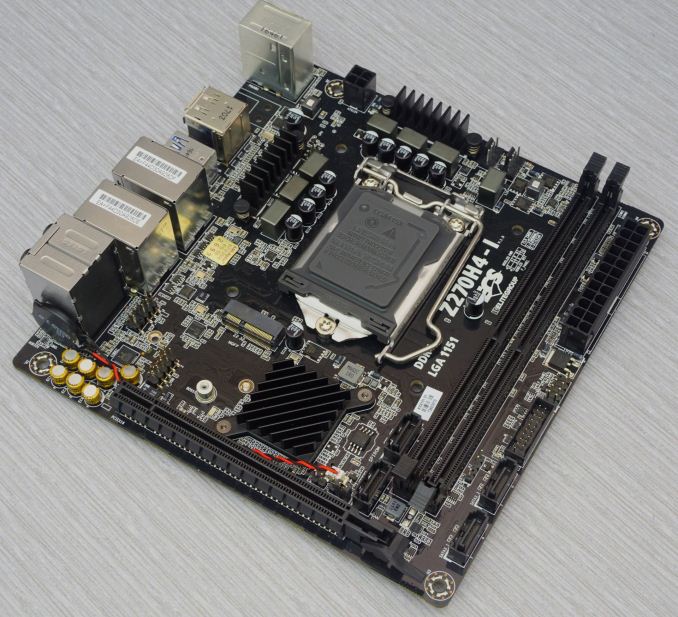
In this review, we are having a look at the first ITX motherboard based on Intel’s Z270 chipset to find its way into our labs, the ECS (Elitegroup Computer Systems) Z270H4-I Durathon 2 Mini ITX. The company’s approach is to create a compact and reliable, yet cost effective motherboard for typical home entertainment and gaming systems. A quick look at its specifications reveals very interesting features for a motherboard that retails for less than $110, with the marketing team even praising its overclocking capabilities. We will examine its core features and capabilities in the following pages of this review.
Other AnandTech Reviews for Intel’s 7th Generation CPUs and 200-Series Motherboards
($109) The ECS Z270H4-I Durathon 2 Review (mini-ITX)
($140) The ASRock Z270 Killer SLI Review
($140) The MSI Z270 SLI PLUS Review
($150) The Asus Prime Z270-A
($155) The GIGABYTE Z270X-Ultra Gaming
In comparison to the older Z170 boards, the new Z270 board on the base specifications are hardly any different. The Z270 ones have four extra PCIe lanes configurable on the chipset, potentially new audio and new networking controllers, and Intel Optane Technology Support. Although four extra PCIe lanes do sound like a huge difference, it is an important upgrade for the implementation of native M.2 slots (on Z170-based motherboards, this usually meant disabling some other device/port on the motherboard). Also, note that Intel Optane drives should still function on other chipsets as drives; the Z270 only allows them to enable their “smart caching” technology.
The Intel Optane Memory (SSD) Preview: 32GB of Kaby Lake Caching
Individual motherboard manufacturers will be sprinkling on new features onto their Z270 products to aid the transition and provide other tangible benefits over the old platform. To read specifically about the Z170 chip/platform and the specifications therein, our deep dive into what it is can be found at this link.
ECS Z270H4-I Durathon 2 Overview
The design of a low-cost motherboard is usually simpler than bigger designs, with the manufacturer sticking to the integration of the most common features. The ECS Z270H4-I Durathon 2 is, by contrast, an unusual product. With the company intending to market it towards gamers and overclockers rather than HTPC/casual users, the designers of the Z270H4-I try to implement features that gamers could use but, in order to keep the manufacturing cost low, skipped features that they thought gamers do not have a use for.
A quick glance reveals the presence of dual Gigabit LAN, something that we do not expect to find on cost-effective designs, for example, both of the Gigabit controllers are high-performance chipsets but from different manufacturers (Realtek 8118AS + Intel I-219V). The HD audio CODEC also comes from Realtek and is the popular ALC1150. It has four SATA 6Gb/s connectors, which are adequate for a Mini ITX motherboard. There are also two M.2 slots but only the one at the rear of the motherboard can support SSD drives. The M.2 slot at the front of the motherboard is for a WiFi/Bluetooth M.2 card, which is not included in this motherboard’s bundle. There are many USB 2.0 and USB 3.0 ports and headers, yet not a single USB 3.1 10 Gb/s Type-C or Type-A port, which is a cost cutting measure, unfortunately for anyone with a modern high-speed mobile or storage device.
As ECS is trying to promote the Z270H4-I towards gamers, and its marketing focuses most of their effort on the motherboard’s reliability and overclocking capability. On its default settings, the Z270H4-I does perform just as well (or even slightly better) than any of the Z270-based ATX gaming motherboards that we reviewed recently, yet that is because of the BIOS settings that allow the Z270H4-I to persistently run the CPU at its maximum turbo frequency. Other than that, the overclocking capabilities of the Z270H4-I left us indifferent - it has a very broad range of overclocking options but the actual capabilities of the motherboard are highly limited by its power circuitry and thermal design.
Quick Board Feature Comparison
| Motherboard Comparison | ||
| ECS Z270H4-I Durathon 2 | ||
| Socket | LGA1151 | LGA1151 |
| MSRP at Review | $109 | $140 |
| DRAM | 2 x DDR4 | 4 x DDR4 |
| PCIe Layout | x16 | x8/x8 |
| BIOS Version Tested | 17.03.09 | 2.00 |
| MCT Enabled Automatically? | Yes | Yes |
| USB 3.1 (10 Gbps) | N/A | None |
| M.2 Slots | 1 x SSD 1 x WiFi-only |
2 x PCIe 3.0 x4 |
| U.2 Ports | No | No |
| Network Controller | 1 x Intel I219-V / 1 × Realtek 8118AS | 1 x Intel I219-V |
| Audio Controller | Realtek ALC1150 | Realtek ALC892 |
| HDMI 2.0 | No | No |
ECS Z270H4-I Durathon 2 Overclocking
Experience with ECS Z270H4-I Durathon 2
Even though ECS’s marketing is strongly focused on the overclocking capabilities of the ECS Z270H4-I Durathon 2, our overclocking experience was mediocre at best. The BIOS settings are more than adequate and the range of most options is very broad. Some of the voltage settings even are ridiculously broad, such as, for example, the motherboard allowing the CPU core voltage to go up to 2.5 volts.
A quick glance during our very first visit into the BIOS revealed that the Z270H4-I has, like most motherboards nowadays, the multi-core turbo option pre-enabled, boosting the turbo performance of the CPU up to 4.5 GHz for the first core and 4.4 GHz for the other three cores. This option is by default enabled on the vast majority of modern motherboards, allowing the system to temporarily push the CPUs slightly above their regular ratio. What is very peculiar however is that, by default, the BIOS is set to override the CPU power and ratio limits. Our preliminary testing revealed that, without manually tweaking any BIOS settings, the Z270H4-I was persistently pushing our 7700K up to 4.4 GHz with either single-thread or multi-thread loads.
Methodology
Our standard overclocking methodology is as follows. We select the automatic overclock options and test for stability with PovRay and OCCT to simulate high-end workloads. These stability tests aim to catch any immediate causes for memory or CPU errors.
For manual overclocks, based on the information gathered from previous testing, starts off at a nominal voltage and CPU multiplier, and the multiplier is increased until the stability tests are failed. The CPU voltage is increased gradually until the stability tests are passed, and the process repeated until the motherboard reduces the multiplier automatically (due to safety protocol) or the CPU temperature reaches a stupidly high level (100ºC+). Our test bed is not in a case, which should push overclocks higher with fresher (cooler) air.
Overclock Results
Unlike other motherboards, the Z270H4-I does not have any “automatic” CPU overclocking settings that automatically tweak the CPU’s voltage and ratio to predefined values. Any overclocking needs to be performed manually. However, no matter the voltage and power limit settings, we soon found out that the Z270H4-I simply would not drive our 7700K above 4.5 GHz. As seen in the following picture, even though the CPU ratio was set at ×49, all power limits were disabled and there were no thermal issues, the motherboard is maintaining a CPU frequency of 4.5 GHz under full load. We are unsure if that is due to a BIOS bug that needs to be resolved or, most likely, due to the physical limitations of the motherboard’s power circuitry. We also had no luck with BCLK/FSB overclocking, as the Z270H4-I was entirely unstable with the frequency set at anything higher than 104 MHz.
ECS Z270H4-I Durathon 2 Board Features
ECS designed the Z270H4-I with casual gamers in mind, for users that want to build a reasonably powerful but compact living room PC without breaking the bank. As such, the designers of this ITX motherboard tried to implement features that appeal to gamers but, in order to keep the costs down, omitted other features that we are nowadays used to seeing on every >$100 design. For example, the Z270H4-I has dual Gigabit LAN and a good audio CODEC installed but there is no USB 3.1 (10 Gb/s) chipset, limiting its users up to USB 3.0 speeds.
| ECS Z270H4-I Durathon 2 | |
| Warranty Period | 3 Years |
| Product Page | Link |
| Price | Link |
| Size | Mini ITX |
| CPU Interface | LGA1151 |
| Chipset | Intel Z270 |
| Memory Slots (DDR4) | Two DDR4 Supporting 32GB Dual Channel Up to 3200 MHz |
| Memory Slots (DDR3L) | None |
| Video Outputs | HDMI 1.4 DVI-D DisplayPort 1.2 |
| Network Connectivity | Intel I219-V + Realtek 8118AS |
| Onboard Audio | Realtek ALC1150 |
| PCIe Slots for Graphics (from CPU) | 1 x PCIe 3.0 (x16) |
| PCIe Slots for Other (from PCH) | None |
| Onboard SATA | Four, RAID 0/1/5/10 |
| Onboard SATA Express | None |
| Onboard M.2 | 1 × PCIe 3.0 x4 SSD (2280) 1 × WiFi-only |
| Onboard U.2 | None |
| USB 3.1 | None |
| USB 3.0 | 5 × Type-A Rear Panel 1 × Type-C Rear Panel 2 × via headers |
| USB 2.0 | 2 x Rear Panel 1 × via headers |
| Power Connectors | 1 x 24-pin ATX 1 x 4-pin CPU |
| Fan Headers | 1 x CPU (4-pin) 1 x Pump (4-pin) |
| IO Panel | 5 x USB 3.0 (USB 3.1 Gen 1) 1 x USB 3.0 Type-C 2 x USB 2.0 2 x Network RJ-45 1 x DisplayPort 1.2 1 x HDMI 1.4a 1 x Combo PS/2 5 x 3.5 mm Audio Jacks 1 x Optical SPDIF Out Port |
| Other Features | 1 X M.2 slot for WiFi/BT Supports Intel® Optane™ technology Front Audio Header |
In The Box
We get the following:
- Driver Disk
- Manual
- Rear I/O Shield
- Two black SATA cables (both straight)
- Two wireless antennas
- Wireless antenna bracket
Inside the box, we found the basic bundled items that accompany any motherboard, which are the user’s manual, a drivers/applications DVD, a metallic I/O shield, and two SATA cables. ECS also includes two wireless antennas and a bracket for them. However, the Z270H4-I Durathon 2 does not have a Wi-Fi/Bluetooth chipset onboard. These will only be useful to users that will purchase a separate M.2 Wi-Fi/Bluetooth device.
Visual Inspection
Considering the very small dimensions and cost-effective nature of the Z270H4-I Durathon 2, we did not expect that the company’s engineers would place too much effort on aesthetics. The Z270H4-I Durathon 2 is an all-black motherboard but there is no LED lighting, plastic covers, or fancy heatsinks. As a matter of fact, the heatsinks are very basic and their size is minimal. The two VRM heatsinks are particularly inadequate, barely covering half of each’s MOSFET’s surface, which is not pleasing to witness on a motherboard that is being praised for its overclocking potential.
The engineers did what they could with the position of the headers. As there is no space below the one and only PCIe ×16 slot, so the front panel audio and USB 2.0 header had to be placed above it, behind the 3.5 mm audio jacks. A small M.2 slot can also be seen on the lower left part of the motherboard, next to the chipset. This M.2 slot is not meant for SSD drives but for M.2 Wi-Fi/Bluetooth devices that the user will have to buy separately in order to make use of the supplied antennas. The Z270H4-I Durathon 2 has a single M.2 slot meant for 2242/2280 drives on the underside of the PCB.
The front panel I/O header and the USB 3.0 header are at the right edge of the motherboard. All four SATA ports are at the lower right corner of the PCB, with two of them being right at the edge and easily accessible. The other two SATA ports are behind the RAM slots and access to them can be very difficult, or even impossible when the system is fully assembled, as the user will have to reach them between the GPU, the RAM modules and a sizable CPU cooler.
There are only two fan headers on the Z270H4-I Durathon 2, both right above the CPU socket. We can also notice that the CPU 12V power connector is 4-pin, which is barely sufficient for a high-end 1151 processor, let alone for serious overclocking.
The rear panel of the ECS Z270H4-I Durathon 2 is rich, starting with a PS/2 combo port and two USB 2.0 ports at the top of the motherboard. The small gap between the USB 2.0 ports and the Displayport 1.2/HDMI 1.4a ports is meant for the wireless antenna bracket we saw bundled alongside with the motherboard. The HDMI port is limited to 30Hz @ 3840 × 2160 or 24Hz @ 4096 × 2160, but the DisplayPort 1.2 is capable of 60 Hz @ 4096 x 2304. There are six USB 3.0 ports, with five of them being Type-A and one being Type-C. Two USB 3.0 port pairs share their supports with one LAN port each. There are five 3.5 mm analog audio jacks, all of which are gold plated, plus one optical SPDIF port.
ECS is not trying to hide/rebrand the motherboard’s components. We can clearly see that all of the motherboard’s capacitors are solid-state polymers. With the exception of the gold capacitors on the audio circuit that are supplied by Nichicon, every other capacitor is a CapXon product. CapXon is not the most popular capacitor manufacturer but they are generally considered to be reliable.
As we mentioned above, the VRM heatsinks are barely adequate for the basic cooling needs of this motherboard. They are so narrow that barely cover half the surface of each VRM MOSFET, but at least they do make good contact. With the heatsinks removed, we can see a basic 6-phase VRM design that is adequate for typical use but not recommended for overclocking. The overall power circuitry and its cooling, in conjunction with the 4-pin CPU power connector, easily explains why the motherboard was power-limiting our processor during our overclocking tests.
The VRM controller is an Intersil ISL69137, a high-performance 7-phase dual output controller. NIKO Semiconductor, a reputable manufacturer whose products we commonly find on mainstream motherboards, supplies the PK650BA and PK516BA MOSFETS of the power circuitry.
BIOS
The ECS Z270H4-I Durathon 2 features a graphical BIOS which expectedly defaults in the “easy” mode. The “easy” mode allows the user to tweak only the boot device priority and select one of the pre-programmed performance profiles, with the rest of the display being of purely informative nature, graphically displaying the CPU and system temperature, CPU and system fan speeds, and CPU/DIMM/12V voltages.
In order to access more options and features, the user needs to go into the “Advanced” mode (F7). The advanced mode has eight menus but there are dozens of submenus hidden into some of them.
In the advanced mode, the screen is essentially split into three parts. The top bar displays the main menu selection, the left side of the screen lists the options and the right side of the screen displays a navigation legend and information on the highlighted option.
The first and default main menu option is the “Main” screen, which only has three tweakable options: the system’s language, the date and the time. A fourth line indicates the BIOS version. The “Advanced” menu lists nine submenus, with most of them being options related to the onboard controllers. One option that stands out is the “PC health status”, which is an informative screen that displays basic voltage and temperature information but also hides the “Smart Fan” controls and settings that would allow the user to manually control the speeds of the attached fans. This option would be much easier to find in the “M.I.B. X” menu, alongside with all frequency/timing/voltage controls.
The third main menu option brings up the “Chipset” screen, which only has three submenus with a few chipset-related options each. Strangely, we found the power state after power loss option in the “PCH configuration” submenu, an option that clearly should have been inside the “Power Management” submenu that we found in the previous screen.
The fourth and most important main menu option is the “M.I.B. X”, which stands for “Motherboard Intelligent BIOS X”. This screen has five submenus that hide all of the motherboard’s frequency, timing, and voltage controls. We found the CPU frequency/ratio/power configuration options into the first submenu and made an interesting discovery: by default, the CPU power limits were overridden and its turbo ratios were set at 45× for the first core and 44× for the other three cores. Most manufacturers nowadays ship their motherboards with multi-core turbo enabled, but this is the first time that we have seen a manufacturer overriding the default power limits.
The “memory configuration” submenu also has a very long list of options, most of which are beyond the understanding of even experienced overclockers. Another very interesting submenu is the “over voltage configuration”, which holds few voltage control options that technically cover only the CPU and DIMM voltages. The range of these voltage settings is ridiculous, with the ECS Z270H4-I Durathon 2 being capable, in theory, to push the CPU voltage up to 2.5 volts. The step of these settings, however, is relatively large for their respective useful ranges. For example, the CPU voltage setting has a step of 50 mV, which is not great for advanced users that like to fine-tune their systems. Note that the BIOS adjusts the voltage settings live, meaning that the voltages change instantly when the user tweaks the options, making it exceptionally dangerous to fiddle with these settings without at least basic experience and/or lacking focus!

Settings are changed LIVE, so we didn't stay at 2.5V for long
The “Security” main menu lists options that we usually find into other menus/submenus. Here we found the administrator password settings, usually found under the “Main” or “System” menus, and the Secure Boot options that would most likely fit best into the next main menu option of this BIOS, the “Boot” menu, which lists all of the boot-related settings. We found out-of-place options even in the “Exit” screen, with the first being the trigger to switch the BIOS back to the easy mode, which should certainly be inside the “Main” menu and as the first option as well, allowing users that accidentally entered the advanced BIOS configuration to go back to the easy mode. The other option that we feel it should be moved is the “Boot Override” option, which would probably fit best into the “Boot” main menu, yet it restarts the system so we can understand why the BIOS’ programmer placed it here.
Software
It seems that Google is aggressively promoting their products via all motherboard manufacturers nowadays, as we find the included driver’s DVDs pushing the users to install Chrome as their default browser. ECS’s disk is no different, with Google’s software pushing for an installation alongside the basic system drivers. There is no option to manually select only certain driver packages here, only a “setup” button that will bring up an installer for all of the system’s drivers. The user can select which drivers to install from inside the automated installer.
There are only three utilities included inside the DVD, the “eBLU”, “eDLU”, and “eSF”. The “eDLU” stands for “Driver Live Update” and is a simple utility that will check the versions of your drivers against those at the manufacturer’s website and, if there are newer versions available, install them. Similarly, the “eBLU” stands for “BIOS Live Update” and is a simple utility that checks for newer BIOS versions.
The third utility, the “eSF”, stands for “smart fan” and is a very simple utility that allows the user to control thermal control profiles for the two attached fans. There are four pre-programmed profiles, plus a custom setting that allows the user to manually control the fan spin up and down points. Note however that the axes do not have any tick labels, forcing the user to roughly guess the temperature points.
Readers of our motherboard review section will have noted the trend in modern motherboards to implement a form of MultiCore Enhancement / Acceleration / Turbo (read our report here) on their motherboards. This does several things, including better benchmark results at stock settings (not entirely needed if overclocking is an end-user goal) at the expense of heat and temperature. It also gives, in essence, an automatic overclock which may be against what the user wants. Our testing methodology is ‘out-of-the-box’, with the latest public BIOS installed and XMP enabled, and thus subject to the whims of this feature. It is ultimately up to the motherboard manufacturer to take this risk – and manufacturers taking risks in the setup is something they do on every product (think C-state settings, USB priority, DPC Latency/monitoring priority, overriding memory sub-timings at JEDEC). Processor speed change is part of that risk, and ultimately if no overclocking is planned, some motherboards will affect how fast that shiny new processor goes and can be an important factor in the system build.
The ECS Z270H4-I Durathon 2 is a shining example of the abovementioned methodology risks. While almost every manufacturer has multi-core acceleration enabled by default, ECS not only enables this feature by default but also has the Z270H4-I Durathon 2 pushing our 7700K to 4.4GHz, which is its turbo setting, and maintaining it while the CPU remains under load. We tested the Z270H4-I Durathon 2 with the 17/03/09 BIOS.
| Test Setup | |
| Processor | Intel Core i7-7700K (ES, Retail Stepping), 91W, $340 4 Cores, 8 Threads, 4.2 GHz (4.5 GHz Turbo) |
| Motherboards | ECS Z270H4-I Durathon 2 |
| Cooling | Alphacool Eisbaer 240 |
| Power Supply | Corsair AX1200i Platinum PSU |
| Memory | G.Skill DDR4-2400 C15 2x16 GB 1.2V |
| Memory Settings | XMP @ 2400 |
| Video Cards | MSI GTX 770 Lightning 2GB (1150/1202 Boost) |
| Hard Drive | Crucial MX200 1TB |
| Case | Open Test Bed |
| Operating System | Windows 7 64-bit SP1 |
Thank you to Crucial for providing us with MX200 SSDs. Crucial stepped up to the plate as our benchmark list grows larger with newer benchmarks and titles, and the 1TB MX200 units are strong performers. Based on Marvell's 88SS9189 controller and using Micron's 16nm 128Gbit MLC flash, these are 7mm high, 2.5-inch drives rated for 100K random read IOPs and 555/500 MB/s sequential read and write speeds. The 1TB models we are using here support TCG Opal 2.0 and IEEE-1667 (eDrive) encryption and have a 320TB rated endurance with a three-year warranty.
Further Reading: AnandTech's Crucial MX200 (250 GB, 500 GB & 1TB) Review
Thank you to Corsair for providing us with an AX1200i PSU. The AX1200i was the first power supply to offer digital control and management via Corsair's Link system, but under the hood it commands a 1200W rating at 50C with 80 PLUS Platinum certification. This allows for a minimum 89-92% efficiency at 115V and 90-94% at 230V. The AX1200i is completely modular, running the larger 200mm design, with a dual ball bearing 140mm fan to assist high-performance use. The AX1200i is designed to be a workhorse, with up to 8 PCIe connectors for suitable four-way GPU setups. The AX1200i also comes with a Zero RPM mode for the fan, which due to the design allows the fan to be switched off when the power supply is under 30% load.
Further Reading: AnandTech's Corsair AX1500i Power Supply Review
Thank you to G.Skill for providing us with memory. G.Skill has been a long-time supporter of AnandTech over the years, for testing beyond our CPU and motherboard memory reviews. We've reported on their high capacity and high-frequency kits, and every year at Computex G.Skill holds a world overclocking tournament with liquid nitrogen right on the show floor.
Further Reading: AnandTech's Memory Scaling on Haswell Review, with G.Skill DDR3-3000
System Performance
Not all motherboards are created equal. On the face of it, they should all perform the same and differ only in the functionality they provide - however, this is not the case. The obvious pointers are power consumption, but also the ability for the manufacturer to optimize USB speed, audio quality (based on audio codec), POST time and latency. This can come down to manufacturing process and prowess, so these are tested.
Power Consumption
Power consumption was tested on the system while in a single MSI GTX 770 Lightning GPU configuration with a wall meter connected to the Corsair AX1200i power supply. This power supply is Platinum rated, and as I am on a 230-240 V supply, leads to ~75% efficiency > 50W, and 90%+ efficiency at 250W, suitable for both idle and multi-GPU loading. This method of power reading allows us to compare the power management of the UEFI and the board to supply components with power under load, and includes typical PSU losses due to efficiency. These are the real-world values that consumers may expect from a typical system (minus the monitor) using this motherboard.
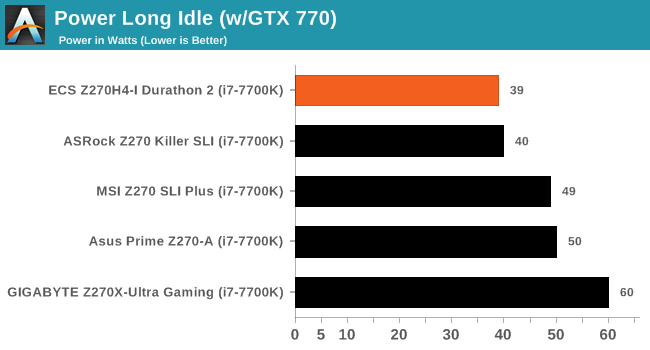

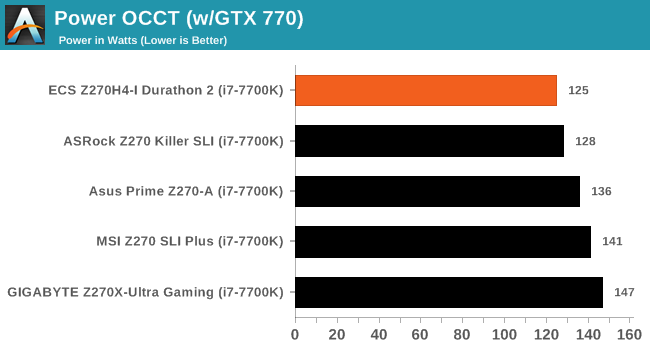
Expectedly, the energy consumption of the ECS Z270H4-I Durathon 2 is a little lower than that of the Z270-based ATX motherboards that we have previously reviewed. The difference, however, is small, with the Z270H4-I Durathon 2 displaying power readings about 3 to 8 watts lower than those of an ATX board with its onboard lighting disabled.
Non-UEFI POST Time
Different motherboards have different POST sequences before an operating system is initialized. A lot of this is dependent on the board itself, and POST boot time is determined by the controllers on board (and the sequence of how those extras are organized). As part of our testing, we look at the POST Boot Time using a stopwatch. This is the time from pressing the ON button on the computer to when Windows 7 starts loading. (We discount Windows loading as it is highly variable given Windows specific features.)

The default boot time of the ECS Z270H4-I Durathon 2 is a little slow, with the motherboard taking quite a while to display the initial BIOS screen. Enabling quick boot does cut that time significantly, bringing the motherboard’s POST boot time down to competitive levels.
Rightmark Audio Analyzer 6.2.5
Rightmark:AA indicates how well the sound system is built and isolated from electrical interference (either internally or externally). For this test, we connect the Line Out to the Line In using a short six inch 3.5mm to 3.5mm high-quality jack, turn the OS speaker volume to 100%, and run the Rightmark default test suite at 192 kHz, 24-bit. The OS is tuned to 192 kHz/24-bit input and output, and the Line-In volume is adjusted until we have the best RMAA value in the mini-pretest. We look specifically at the Dynamic Range of the audio codec used on board, as well as the Total Harmonic Distortion + Noise.
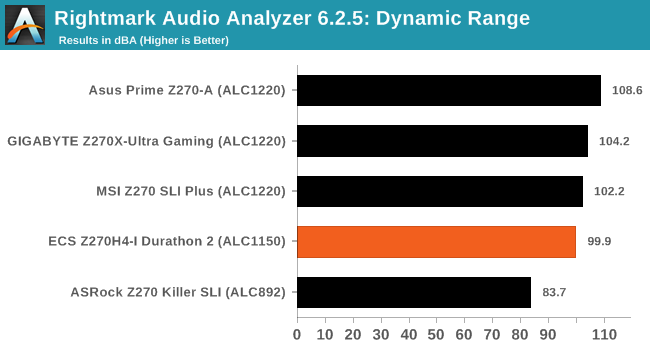
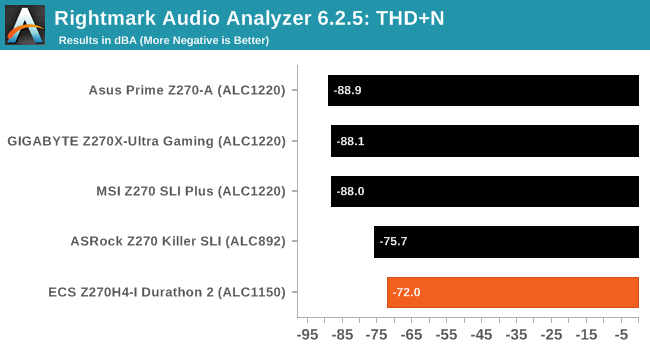
The audio performance figures of the ECS Z270H4-I Durathon 2 are interesting. The Realtek ALC1150 is known to offer good audio quality figures but its implementation on the Z270H4-I Durathon 2 left us with mixed feelings. The dynamic range reached 99.9 dB(A), a very good figure, but the THD + Noise down to -72 dB(A), indicating that there is a lot of interference from other nearby components. This is something to be expected on densely packed ITX motherboards.
USB Backup
For this benchmark, we transfer a set size of files from the SSD to the USB drive using DiskBench, which monitors the time taken to transfer. The files transferred are a 1.52 GB set of 2867 files across 320 folders – 95% of these files are small typical website files, and the rest (90% of the size) are small 30 second HD videos. In an update to pre-Z87 testing, we also run MaxCPU to load up one of the threads during the test which improves general performance up to 15% by causing all the internal pathways to run at full speed.
Due to the introduction of USB 3.1, as of June 2015, we are adjusting our test to use a dual mSATA USB 3.1 Type-C device which should be capable of saturating both USB 3.0 and USB 3.1 connections. We still use the same data set as before, but now use the new device. Results are shown as seconds taken to complete the data transfer.
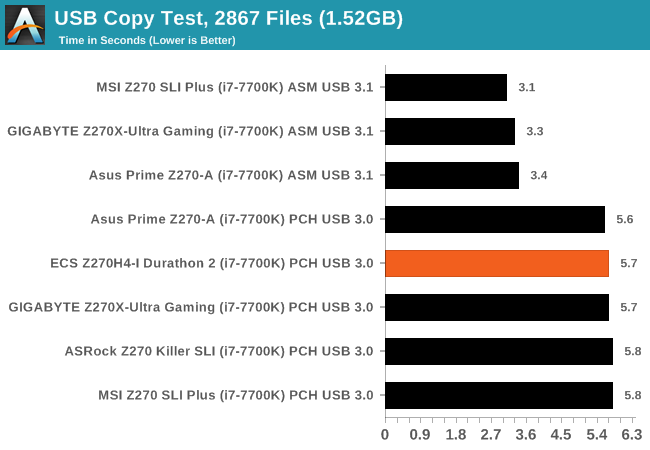
The ECS Z270H4-I Durathon 2 lacks a USB 3.1 controller we were limited to USB 3.0 testing. The USB 3.0 performance of the motherboard is adequate, falling around the ATX motherboards that we have recently tested, but with the performance difference being so small that could be easily attributed to a statistical error.
DPC Latency
Deferred Procedure Call latency is a way in which Windows handles interrupt servicing. In order to wait for a processor to acknowledge the request, the system will queue all interrupt requests by priority. Critical interrupts will be handled as soon as possible, whereas lesser priority requests such as audio will be further down the line. If the audio device requires data, it will have to wait until the request is processed before the buffer is filled.
If the device drivers of higher priority components in a system are poorly implemented, this can cause delays in request scheduling and process time. This can lead to an empty audio buffer and characteristic audible pauses, pops, and clicks. The DPC latency checker measures how much time is taken processing DPCs from driver invocation. The lower the value will result in better audio transfer at smaller buffer sizes. Results are measured in microseconds.

Many manufacturers do not concern themselves with optimizing the DPC latency figures and ECS is apparently one of them. Our maximum reading reached 265 μs, a relatively high figure for a modern motherboard.
CPU Performance, Short Form
For our motherboard reviews, we use our short form testing method. These tests usually focus on if a motherboard is using MultiCore Turbo (the feature used to have a maximum turbo on at all times, giving a frequency advantage), or if there are slight gains to be had from tweaking the firmware. We leave the BIOS settings at default and memory at JEDEC (DDR4-2133 C15) for these tests, making it very easy to see which motherboards have MCT enabled by default.
Video Conversion – Handbrake v0.9.9: link
Handbrake is a media conversion tool that was initially designed to help DVD ISOs and Video CDs into more common video formats. For HandBrake, we take two videos (a 2h20 640x266 DVD rip and a 10min double UHD 3840x4320 animation short) and convert them to x264 format in an MP4 container. Results are given in terms of the frames per second processed, and HandBrake uses as many threads as possible.
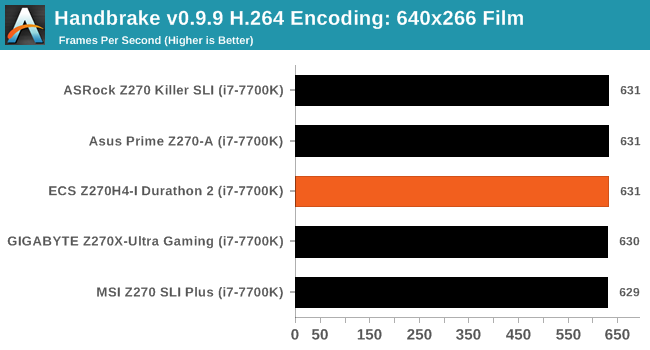
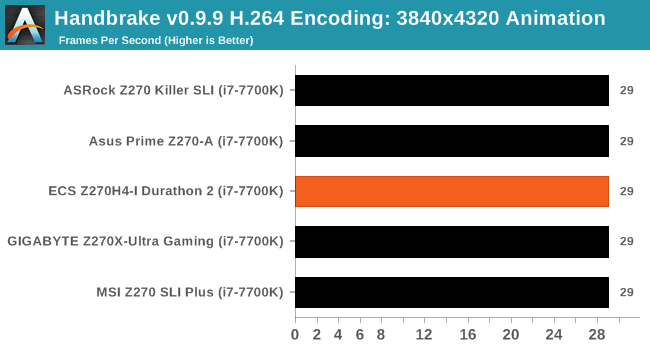
Compression – WinRAR 5.0.1: link
Our WinRAR test from 2013 is updated to the latest version of WinRAR at the start of 2014. We compress a set of 2867 files across 320 folders totaling 1.52 GB in size – 95% of these files are small typical website files, and the rest (90% of the size) are small 30-second 720p videos.
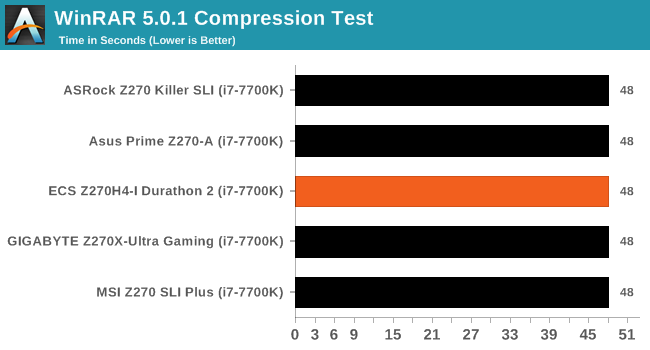
Point Calculations – 3D Movement Algorithm Test: link
3DPM is a self-penned benchmark, taking basic 3D movement algorithms used in Brownian Motion simulations and testing them for speed. High floating point performance, MHz, and IPC win in the single thread version, whereas the multithread version has to handle the threads and loves more cores. For a brief explanation of the platform agnostic coding behind this benchmark, see my forum post here.
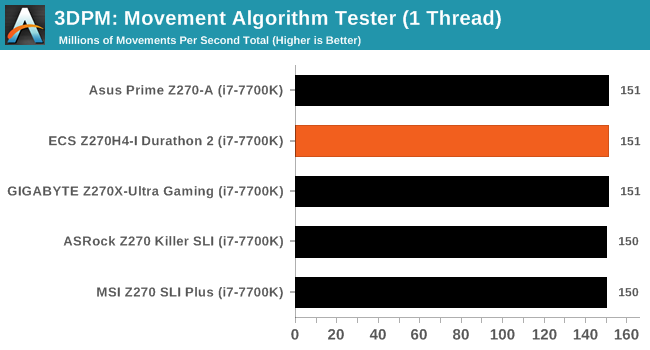
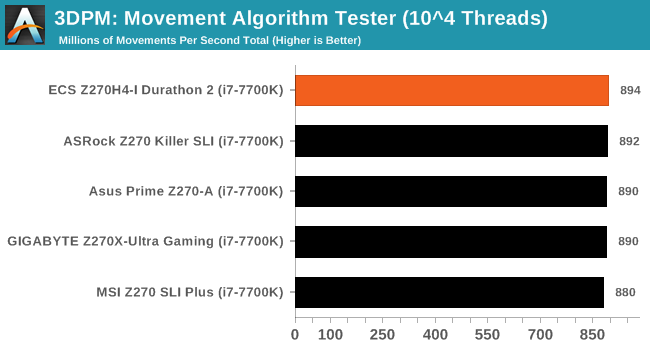
Rendering – POV-Ray 3.7: link
The Persistence of Vision Ray Tracer, or POV-Ray, is a freeware package for as the name suggests, ray tracing. It is a pure renderer, rather than modeling software, but the latest beta version contains a handy benchmark for stressing all processing threads on a platform. We have been using this test in motherboard reviews to test memory stability at various CPU speeds to good effect – if it passes the test, the IMC in the CPU is stable for a given CPU speed. As a CPU test, it runs for approximately 2-3 minutes on high-end platforms.
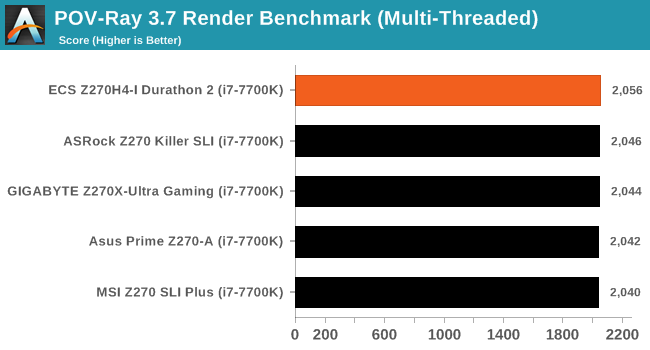
Synthetic – 7-Zip 9.2: link
As an open source compression tool, 7-Zip is a popular tool for making sets of files easier to handle and transfer. The software offers up its own benchmark, to which we report the result.
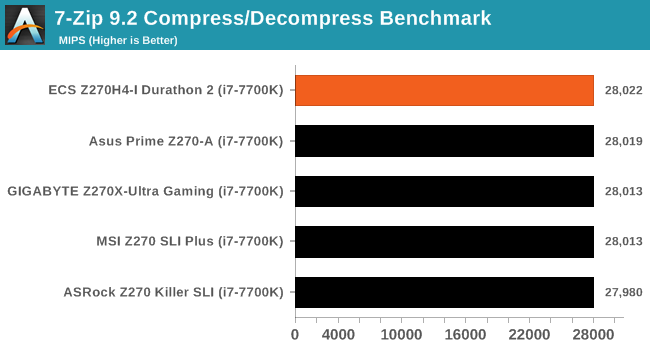
Gaming Performance
For Intel's Z97 and Z170 platform, the issue of FCLK settings might play a big role here. At launch, the default setting for the communication buffer between the CPU and PCIe stack was 800 MHz, even though Intel suggested 1000 MHz, but this was because of firmware limitations from Intel. Since then, there is firmware to enable 1000 MHz, and most motherboard manufacturers have this - but it is unclear if the motherboard will default to 1000 MHz and it might vary from BIOS version to BIOS version. As we test at default settings, our numbers are only ever snapshots in time, but it leads to some interesting differences in discrete GPU performance.
The gaming tests in our motherboard reviews aremore of a checkbox for abnormal behavior, as with the CPU tests, to make sure nothing fishy is going on.
Total War: Attila
The Total War franchise moves on to Attila, another The Creative Assembly development, and is a stand-alone strategy title set in 395AD where the main storyline lets the gamer take control of the leader of the Huns in order to conquer parts of the world. Graphically the game can render hundreds/thousands of units on screen at once, all with their individual actions and can put some of the big cards to task.
For low-end graphics, we test at 720p with performance settings, recording the average frame rate. With mid and high range graphics, we test at 1080p with the quality setting. In both circumstances, unlimited video memory is enabled and the in-game scripted benchmark is used.
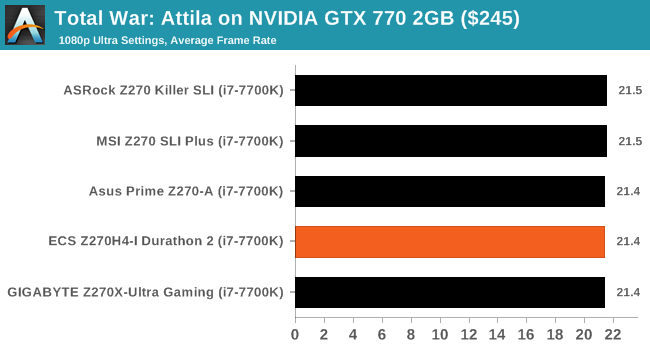
GRID: Autosport
No graphics tests are complete without some input from Codemasters and the EGO engine, which means for this round of testing we point towards GRID: Autosport, the next iteration in the GRID and racing genre. As with our previous racing testing, each update to the engine aims to add in effects, reflections, detail, and realism, with Codemasters making ‘authenticity’ a main focal point for this version.
GRID’s benchmark mode is very flexible and, as a result, we created a test race using a shortened version of the Red Bull Ring with twelve cars doing two laps. The car is focus starts last and is quite fast, but usually finishes second or third. For low-end graphics, we test at 1080p medium settings, whereas mid and high-end graphics get the full 1080p maximum. Both the average and minimum frame rates are recorded.
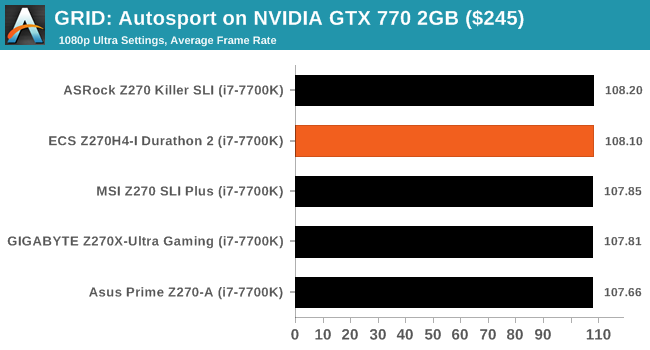
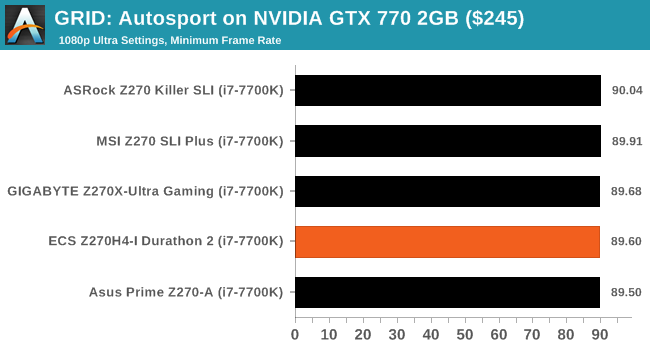
Conclusion
ECS has set a clear target for the Z270H4-I Durathon 2 Mini ITX and that target is mainstream and casual gamers that want to build a simple, compact, cost effective gaming system. The number of supported devices is adequate for a Mini ITX system, allowing the installation of one M.2 2242/2280 SSD and up to additional four SATA devices, which is sufficient for a typical gaming/entertainment system. ECS was also generous with the USB connectors. With five USB 3.0 Type-A, one USB 3.0 Type-C and two USB 2.0 connectors at the rear I/O panel, plus more via the onboard headers, the designer was clearly trying to ensure that there will be enough connectors for several peripherals and multiple input devices, such as gamepads and other gaming controllers. However, the lack of a USB 3.1 chipset will not go unnoticed if the user owns USB 3.1 peripherals, especially if these are storage devices.
The subsystems of the Z270H4-I Durathon 2 Mini ITX are very good for gamers and home users. Two different, high-performance Gigabit LAN controllers quite possibly were an exaggeration on a motherboard aiming to stay cost-effective, as typical gamers and home users very rarely need to join two different networks or team bond the connections (which is not usually seen across different NIC vendors). The implementation of the Realtek ALC1150 CODEC could have been a little better, as the audio quality of this chipset is good but, according to our testing, it appears that there is a significant level of interference. This will not be noticeable by most people but trained ears and audiophiles are very likely to realize the difference.
Rating the overall design and quality of the Z270H4-I Durathon 2 motherboard is a complicated matter. We need to be lenient here, as the designers have only so much space to work with on a 17 cm × 17 cm Mini ITX board. The placement of most headers and ports is functional, with the possible exception of the two SATA ports that were placed in between the GPU, DIMMs, and the CPU cooler, making them practically impossible to reach once the system has been assembled. The components are all coming from reputable manufacturers, improving the long-term reliability of the motherboard. However, we would have liked to see better heatsinks (or at least heatsinks that make full contact with the components) on a motherboard that is being marketed towards overclockers.
Speaking of overclocking, the ECS Z270H4-I Durathon 2 is not a motherboard that we would recommend to any advanced overclocker. The BIOS options are there and their theoretical range is excellent but the Z270H4-I Durathon 2 lacks both the thermal performance and power circuitry required for extended overclocking. Our test sample downright refused to drive our 7700K processor beyond 4.5 GHz, no matter the settings. It is likely that this may be resolved via a future BIOS upgrade, yet we would still not recommend pushing this particular motherboard with high frequency and voltage settings, as it is not designed to handle such abuse and will place its reliability at serious risk.
The CPU and gaming performance of the Z270H4-I Durathon 2 is good. There is virtually no difference between the Mini ITX Z270H4-I Durathon 2 and the ATX motherboards that we have recently reviewed on CPU and gaming benchmarks. Its DPC latency is a little high but it does not reach figures that would have us worry. For typical gaming systems, the Z270H4-I Durathon 2 will perform as expected. The regular home user and typical gamer will find the Z270H4-I Durathon 2 to be an adequate, cost effective solution for a typical home entertainment/gaming system. More advanced users and especially overclockers are unlikely to be satisfied by the simplicity and poor overclocking capabilities of the Z270H4-I Durathon 2, forcing them to look at more expensive solutions.

